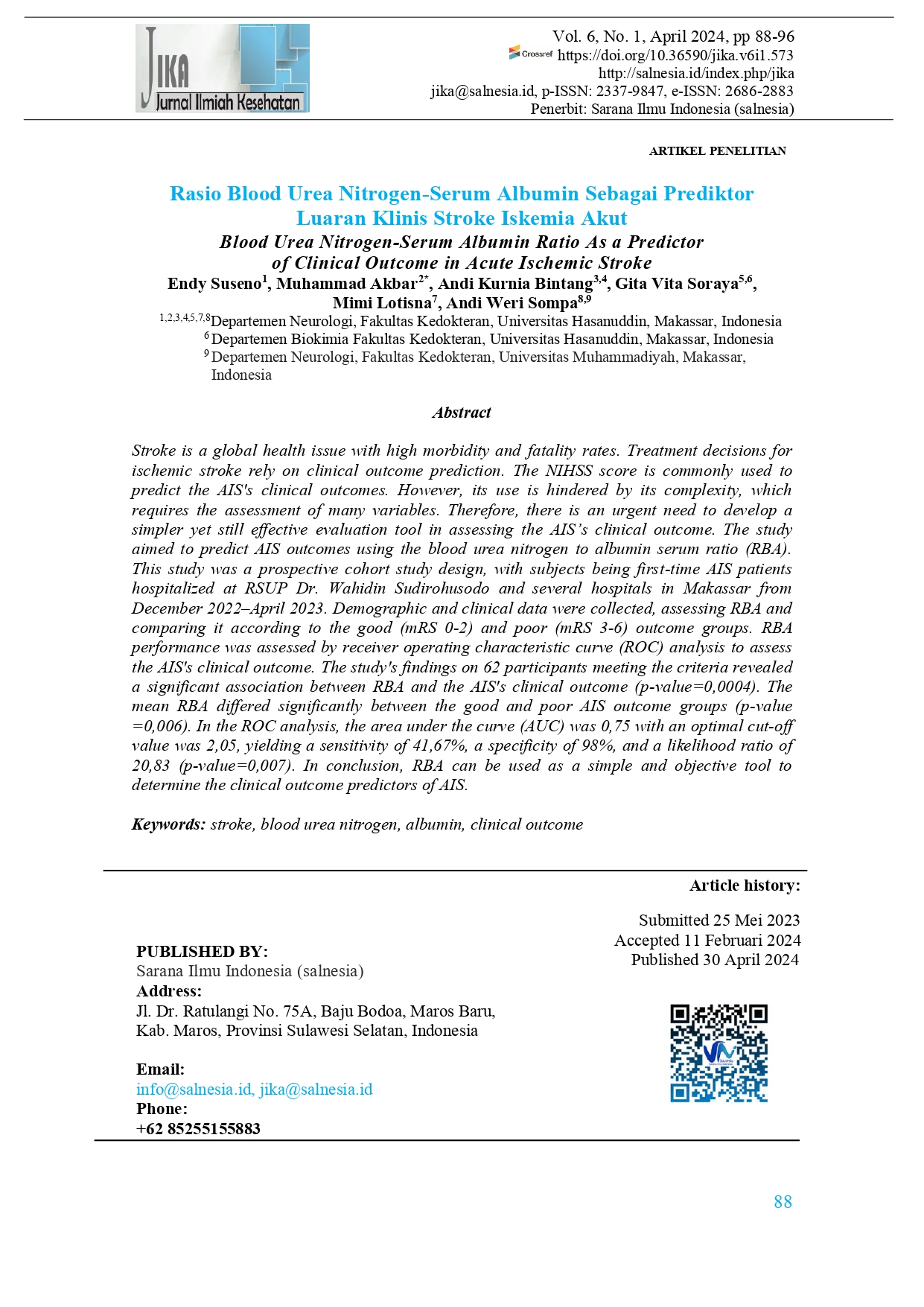Blood Urea Nitrogen-Serum Albumin Ratio As a Predictor of Clinical Outcome in Acute Ischemic Stroke
DOI:
https://doi.org/10.36590/jika.v6i1.573Keywords:
stroke, blood urea nitrogen, albumin, clinical outcomeAbstract
Stroke is a global health issue with high morbidity and fatality rates. Treatment decisions for ischemic stroke rely on clinical outcome prediction. The NIHSS score is commonly used to predict the AIS's clinical outcomes. However, its use is hindered by its complexity, which requires the assessment of many variables. Therefore, there is an urgent need to develop a simpler yet still effective evaluation tool in assessing the AIS’s clinical outcome. The study aimed to predict AIS outcomes using the blood urea nitrogen to albumin serum ratio (RBA). This study was a prospective cohort study design, with subjects being first-time AIS patients hospitalized at RSUP Dr. Wahidin Sudirohusodo and several hospitals in Makassar from December 2022–April 2023. Demographic and clinical data were collected, assessing RBA and comparing it according to the good (mRS 0-2) and poor (mRS 3-6) outcome groups. RBA performance was assessed by receiver operating characteristic curve (ROC) analysis to assess the AIS's clinical outcome. The study's findings on 62 participants meeting the criteria revealed a significant association between RBA and the AIS's clinical outcome (p-value=0,0004). The mean RBA differed significantly between the good and poor AIS outcome groups (p-value =0,006). In the ROC analysis, the area under the curve (AUC) was 0,75 with an optimal cut-off value was 2,05, yielding a sensitivity of 41,67%, a specificity of 98%, and a likelihood ratio of 20,83 (p-value=0,007). In conclusion, RBA can be used as a simple and objective tool to determine the clinical outcome predictors of AIS.
Downloads
References
Babu MS, Kaul S, Dadheech S, Rajeshwar K, Jyothy A, Munshi A. 2013. Serum Albumin Levels in Ischemic Stroke and its Subtypes: Correlation With Clinical Outcome. Nutrition. Elsevier, 29(6): 872-875.
Bae SJ, Lee SH, Yun SJ, Kim K. 2021. Usefulness of The Blood Urea Nitrogen-to-Serum Albumin Ratio As a Prognostic Indicator of Severity in Acute Ischemic Stroke. Signa Vitae, 17(4): 163–170. https://doi.org/10.22514/sv.2021.028.
Belayev L, Liu Y, Zhao W, Busto R, Ginsberg MD. 2001. Human Albumin Therapy of Acute Ischemic Stroke: Marked Neuroprotective Efficacy at Moderate Doses and with A Broad Therapeutic Window. Stroke, 32(2): 553-560. https://doi.org/10.1161/01.STR.32.2.553.
Belayev L, Zhao W, Pattany PM, Weaver RG, Huh PW, Lin B, Busto R, Ginsberg MD. 1998. Diffusion-Weighted Magnetic Resonance Imaging Confirms Marked Neuroprotective Efficacy of Albumin Therapy in Focal Cerebral Ischemia. Stroke, 29(12): 2587-2599. https://doi.org/10.1161/01.STR.29.12.2587.
Darkhabani Z, Nguyen T, Lazzaro MA, Zaidat OO, Lynch JR, Fitzsimmons BF, Linfante I. 2012. Complications of Endovascular Therapy for Acute Ischemic Stroke and Proposed Management Approach. Neurology, 79(13): 192-199. https://doi.org/10.1212/WNL.0b013e31826958e3.
Deng L, Wang C, Qiu S, Bian H, Wang L, Li Y, Wu B, Liu M. 2019. Association Between Blood Urea Nitrogen-to-Creatinine Ratio and Three-Month Outcome in Patients with Acute Ischemic Stroke. Current Neurovascular Research, 16(2): 166–172. https://doi.org/10.2174/1567202616666190412123705.
Departemen Kesehatan. 2019. Riset Kesehatan Dasar (RISKESDAS) 2018. Badan Penelitian dan Pengembangan Kesehatan Departemen Kesehatan, Republik Indonesia 2018.
Dziedzic T, Slowik A, Szczudlik A. 2004. Serum Albumin Level As a Predictor of Ischemic Stroke Outcome. A Journal of Cerebral Circulation, 35(6): 10–12. https://doi.org/10.1161/01.str.0000126609.18735.be.
Feigin VL, Brainin M, Norrving B, Martins S, Sacco RL, Hacke W, Fisher M, Pandian J, Lindsay P. 2022. World Stroke Organization (WSO): Global Stroke Fact Sheet 2022. International Journal of Stroke, 17(1): 18–29. https://doi.org/10.1177/17474930211065917.
Martin-Schild S, Siegler JE, Kumar AD, Lyden P. 2015. Troubleshooting The Nihss: Question-and-Answer Session with One of The Designers. International Journal of Stroke, 10(8): 1284–1286. https://doi.org/10.1111/ijs.12196.
Meyer BC, Hemmen TM, Jackson CM, Lyden PD. 2002. Modified National Institutes of Health Stroke Scale for Use in Stroke Clinical Trials: Prospective Reliability and Validity. Stroke, 33(5): 1261–1266. https://doi.org/10.1161/01.STR.0000015625.87603.A7.
Nair R, Radhakrishnan K, Chatterjee A, Gorthi SP, Vascular J, Neurology I. 2018. Serum Albumin as a Predictor of Functional Outcomes Following Acute Ischemic Stroke, 10(2): 65-68.
Peng R, Liu K, Li W, Yuan Y, Niu R, Zhou L, Xiao Y, Gao H, Yang H, Zhang C, Zhang X, He M, Wu T. 2021. Blood Urea Nitrogen, Blood Urea Nitrogen to Creatinine Ratio and Incident Stroke: The Dongfeng-Tongji Cohort. Atherosclerosis. Elsevier, 333: 1–8. https://doi.org/10.1016/j.atherosclerosis.2021.08.011.
Prajapati KD, Sharma SS, Roy N. 2011. Current Perspectives on Potential Role of Albumin in Neuroprotection. Reviews in The Neurosciences, 22(3): 355-363. https://doi.org/10.1515/RNS.2011.028.
Remmers M, Schmidt-Kastner R, Belayev L, Lin B, Busto R, Ginsberg MD. 1999. Protein Extravasation and Cellular Uptake After High-Dose Human-Albumin Treatment of Transient Focal Cerebral Ischemia in Rats. Brain Research, 827(1-2): 237-242. https://doi.org/10.1016/S0006-8993(99)01304-9.
Rost NS, Bottle A, Lee JM, Randall M, Middleton S, Shaw L, Thijs V, Rinkel GJE, Hemmen TM, Eleopra R, Van Oostenbrugge RJ, Fenwick C, Pelly M, Vaux E, Van Wyk A, Spencer M, Peggy G, Matzkiw H, Newman J. 2016. Stroke Severity is A Crucial Predictor of Outcome: An International Prospective Validation Study. Journal of The American Heart Association, 5(1): 1-7. https://doi.org/10.1161/JAHA.115.002433.
Schrock JW, Glasenapp M, Drogell K. 2012. Elevated Blood Urea Nitrogen/Creatinine Ratio is Associated with Poor Outcome in Patients with Ischemic Stroke. Clinical Neurology and Neurosurgery, 114(7): 881-884. https://doi.org/10.1016/j.clineuro.2012.01.031.
Thanvi B, Treadwell S, Robinson T. 2008. Early Neurological Deterioration in Acute Ischaemic Stroke: Predictors, Mechanisms and Management. Postgraduate Medical Journal, 84(994): 412-417. https://doi.org/10.1136/pgmj.2007.066118.
You S, Zheng D, Zhong C, Wang X, Tang W, Sheng L, Zheng C, Cao Y, Liu CF. 2018. Prognostic Significance of Blood Urea Nitrogen in Acute Ischemic Stroke. Circulation Journal, 82(2): 572-578. https://doi.org/10.1253/circj.CJ-17-0485.

Downloads
Published
How to Cite
Issue
Section
License
Copyright (c) 2024 Endy Suseno, Muhammad Akbar, Andi Kurnia Bintang, Gita Vita Soraya, Mimi Lotisna, Andi Weri Sompa

This work is licensed under a Creative Commons Attribution 4.0 International License.








